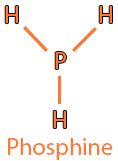Introduction
Phosphine is the compound with the chemical formula PH₃. Phosphine (PH₃) is used as an intermediate in organophosphorus chemistry and as a dopant in the semiconductor industry. Phosphine (PH₃) is alsowidely used as a fumigant (for example, in the tobacco industry) that does not leave residues on the stored product, and for pest control.

How do you remove phosphine (PH₃) from air?
The overall phosphine (PH₃) removal process from air using impregnated activated carbon type AddSorb™ VA4/Ag is as follows:
2PH₃ + 4O₂ → 2H₃PO₄
Phosphine removal (PH₃) with activated carbon is a stepwise process. The first step is the adsorption of phosphine (PH₃) in the micropores of the activated carbon:
PH₃ (g) → PH₃ (in the micro pore, liquid)
Once the phosphine (PH₃) is adsorbed it will oxidise in the presence of a carefully selected metal oxide (MO) impregnate giving the stable diphosphorus trioxide:
2 PH₃ + 3 O₂ → P₂O₃ + 3 H₂O
2 PH₃ + 6 MO → P₂O₃ + 6 M + 3 H₂O
2 M + O₂ → 2 MO
Phosphine (PH₃) can be removed using the Jacobi Group’s non-impregnated activated carbon AddSorb™ KC-Plus as it is physically adsorbed. It is then stabilised by the oxidation to form phosphoric and phosphorous acids.
PH₃ + 2 O₂ → H₃PO₄ (Orthophosphoric acid)
2 PH₃ + 3 O₂ → 2 H₃PO₃ (Orthophosphorus acid)
x PH₃ + 2x O₂ → x (HPO₄)ₓ + x H₂O (Metaphosphoric acid)
x PH₃ + 3x O₂ → x (HPO₂)₂ₓ + x H₂O (Metaphosphorus acid)

